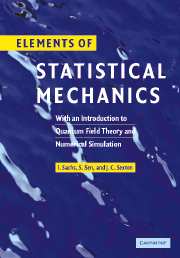 Elements of Statistical Mechanics
Elements of Statistical Mechanics Published online by Cambridge University Press: 29 May 2010
It is time now to review the progress we have made so far. Our starting point was the fundamental atomic nature of matter. We also assumed that interactions between individual atoms and molecules are governed by the laws of mechanics, either classical or quantum depending on the particular circumstances. In the first chapter we developed a simple qualitative picture of the way molecules interact in a complex system. This qualitative picture allowed us to describe classical thermodynamics. In particular we were able to introduce the key concepts of equilibrium, temperature, entropy, and we were able to point out that complex systems in equilibrium can be well described with only a very small number of state variables. Given that matter is made of very large numbers of independent atoms or molecules this is an extraordinary result.
In the second chapter we began the process of formalizing the qualitative link from mechanics to thermodynamics. The formal development starts of course with mechanics. Mechanics on its own, however, is not enough, as it does not contain the concept of thermal equilibrium. The solution we presented was to define thermal equilibrium probabilistically, and the theory which results is statistical mechanics. This solution requires a fundamentally new idea which is not present in mechanics. Once this idea is accepted, the further development of the subject is straightforward if perhaps technically challenging.
Statistical mechanics is a very successful physical theory. In this book, we have applied it to a variety of systems including non-interacting and interacting gases, paramagnetic and spin systems, quantum systems with both Bose and Fermi statistics, astrophysics, helium superfluids and solids.
To save this book to your Kindle, first ensure [email protected] is added to your Approved Personal Document E-mail List under your Personal Document Settings on the Manage Your Content and Devices page of your Amazon account. Then enter the ‘name’ part of your Kindle email address below. Find out more about saving to your Kindle.
Note you can select to save to either the @free.kindle.com or @kindle.com variations. ‘@free.kindle.com’ emails are free but can only be saved to your device when it is connected to wi-fi. ‘@kindle.com’ emails can be delivered even when you are not connected to wi-fi, but note that service fees apply.
Find out more about the Kindle Personal Document Service.
To save content items to your account, please confirm that you agree to abide by our usage policies. If this is the first time you use this feature, you will be asked to authorise Cambridge Core to connect with your account. Find out more about saving content to Dropbox.
To save content items to your account, please confirm that you agree to abide by our usage policies. If this is the first time you use this feature, you will be asked to authorise Cambridge Core to connect with your account. Find out more about saving content to Google Drive.